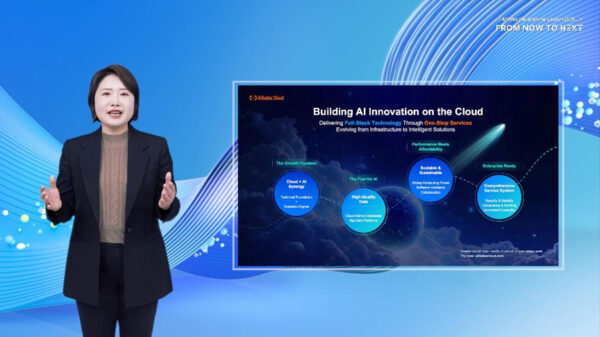By Feifei Li
President of Database Products, Alibaba Cloud Intelligence
In the wake of the pandemic, one trend that emerged is the need for digitalization , which will continue and even grow in the future. While it is still not clear what that actual economic impact of the coronavirus disease ( COVID-19 ) will be, International Data Corporation predicts that the digital economy will accelerate to counter this. The firm forecasts that over 65 percent of the Asia Pacific region’s gross domestic product is expected to be digitalized between 2020 and 2023 and spending will hit US$1.2 trillion.
In the Philippines, 94 percent of IT company decision-maker respondents in Alibaba Cloud’s recent survey entitled “The Role of Cloud in Asia and Confidence in Asian Innovation” said cloud-based tools or digitalization efforts was the most important factor in helping their company mitigate the COVID-19 operating environment, highlighting the importance of digital transformation in sustaining operations amid changing circumstances. More than half of respondents said they adopted more cloud-based IT solutions due to the impact of COVID-19 and 91 percent agreed cloud-based tools or digitalization efforts helped their company meet business and operational needs during the pandemic.
As businesses and even economies become more digitalized, there’s no escaping that data and the ability to gain insights from it are at the heart of every successful organization. The database will also remain the foundation of any successful insight-led architecture.
In this article, I will discuss five database trends that can help businesses and economies surge ahead in the wake of the pandemic.
Hybrid Transaction/Analytical Processing (HTAP): Big Data + Database
Over the past ten years, databases and big data have distanced themselves in their functionality. One is responsible for online workloads while the other covers batch processing vast quantities of data. However, from the perspective of applications, with a single system that can solve the whole process of data generation, processing, storage, and consumption, it can help create a better online experience for customers as they navigate retail websites and services.
From the retailer’s perspective, to improve performance, they need to synchronize several million transactions every day , each bringing with it several different data types as they improve recommendations and the experience for online shoppers. By achieving online and batch workload integration or HTAP, this problem can be easily solved. T his trend will continue to grow over the next decade, which is why Gartner classifies OPDBMS (Operational Database Management Systems) and DMSA (Data Management Solutions for Analytics) into one Cloud DBMS market— this is the core logic behind the integration of the two fields.
Cloud-native Architectures and Distributed Processing Techniques
It is a well-known fact that more and more organizations are adopting cloud infrastructure. They are not only moving their generic business process applications to the cloud but also their mission critical applications and data.
According to a recent industry research, 75 percent of all databases will be deployed or migrated to a cloud platform by 2022. This means that organizations are in need of cloud services and solutions that will support their cloud – native architecture. In fact, business organizations are already developing or sourcing cloud native applications as these allow the business processes to be more dynamic.
Combined with distributed processing techniques and without a heavy infrastructure set up, users can enjoy the elasticity and high availability brought by cloud – native databases with ease and efficiency.
Intelligent & Self-Driving Databases
Cloud computing has changed everything because it has fueled the growth of data. But we are still far from real artificial intelligence (AI). We use deep neural networks today but they need large-scale data to be really useful. AI is a black box today, but AI tech used as heuristics has worked. It has made a mark in computer vision and speech recognition, for example.
Now, it is making a mark in databases too. We will have self-driving databases in the future and our roadmap is to fully automate a database. The complexity in automating databases arises because usage changes from customer to customer, which makes it tough to automate the entire process.
However, we can use AI for common scenarios. For example, we can help different workloads from e-commerce or traditional systems to tune system parameters to improve their latency and scalability and use ML algorithms to ensure that databases are secure and running without anomaly.
Multi-model Databases
It’s hard to imagine that there was a time when there were other database models besides a relational one. Now , there are more types, including document-oriented, graph database, time series, triple store, etc. In a rapidly digitizing world, arriving at insights from heterogeneous data will continue to remain a challenge as businesses seek to derive the most out of newer advances in technology such as AI and the I nternet o f T hings .
Databases will use cloud native design to decouple storage and compute, and be compatible with a wide variety of open-source standard interfaces. They will also support switching between open source systems and seamlessly connecting with multiple computing and analytical engines.
In addition, wide-column table and time series models will be supported, as well as the storage and analysis of structured, semi-structured and unstructured data. This will deliver improved performance for IoT, especially for the multi-model data store, computing and analytics of device metadata, device operation data (time series data) and device logs.
Built-in Security
Once a buzzword and now a fundamental requirement of any application, interface, product and business is security. In the cloud era, maintaining the highest levels of trust and transparency, while securing data in all its forms, will remain a focus for some time to come.
Techniques like encryption in motion with TDE (Transparent Data Encryption), flexible key management, encryption at rest including SSL, traceability and auditing are mandatory and evolving with better efficiency.
In time, what will be significant is how to combine blockchain technology to provide immutable modification in the database system and how to leverage new hardware to encrypt data and process encrypted data without decryption inside databases.











































































































